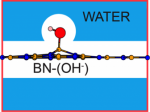
Recent nanofluidic experiments revealed strongly diff erent surface charge measurements for boron-nitride (BN) and graphitic nanotubes when in contact with saline and alkaline water (Nature 2013 , 494 , 455− 458; Phys. Rev. Lett. 2016 , 116 , 154501). These observations contrast with the similar reactivity of a graphene layer and its BN counterpart, using density functional theory (DFT) framework, for intact and dissociative adsorption of gaseous water molecules. Here we investigate, by DFT in implicit water, single and multiple adsorption of anionic hydroxide on single layers. A differential adsorption strength is found in vacuum for the first ionic adsorption on the two materials chemisorbed on BN while physisorbed on graphene. The effect of implicit solvation reduces all adsorption values, resulting in a favorable (nonfavorable) adsorption on BN (graphene). We also calculate a pKa around 6 for BN in water, in good agreement with experiments. Comparatively, the unfavorable results for graphene in water echo the weaker surface charge measurements but point to an alternative scenario.

N’hésitez pas à consulter le communiqué de presse associé à cet article : La réactivité anormale des matériaux bidimensionnels.
References:
Chemisorption of Hydroxide on 2D Materials from DFT Calculations: Graphene versus Hexagonal Boron Nitride
Benoit Grosjean, Clarisse Pean, Alessandro Siria, Lydéric Bocquet, Rodolphe Vuilleumier, and Marie-Laure Bocquet
J. Phys. Chem. Lett. 2016, 7, 4695−4700
DOI: 10.1021/acs.jpclett.6b02248
Chemisorption of Hydroxide on 2D Materials from DFT Calculations: Graphene versus Hexagonal Boron Nitride
